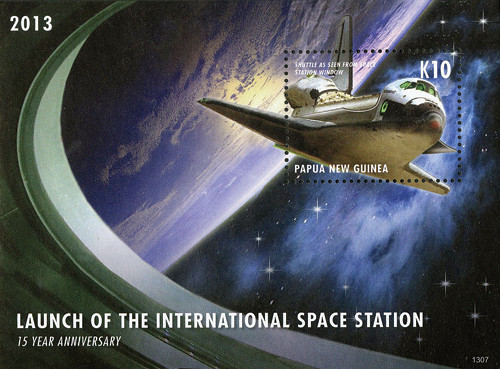
# M11262 - 2013 Papua New Guinea Space S/S
Mint Tribute to International Cooperation in Space
This neat mint Papua New Guinea souvenir sheet features stunning artwork of the view from the International Space Station (ISS). It pictures a shuttle passing by a window with the Earth below. It's a dramatic and attractive tribute to the 15th anniversary of station's launch.
History Behind the International Space Station
In the later years of the Cold War, the United States and the Soviet Union were each working on independent space stations. The Soviets had already launched two space stations with the Salyut and Mir programs. The U.S. had built Skylab, and was working on the Freedom station project.
The end of the Cold War led to increased cooperation between the U.S. and Soviet allies. In 1998, the ongoing work in several countries was combined into a single international project – the ISS. Components from the Russian Mir-2, the U.S. Freedom, the European Columbus, and the Japanese Kibo projects were merged. Russian and American rockets and space shuttles brought the materials and modules into space, and they were assembled in low orbit (about 200 miles above the Earth’s surface).
The ISS is made with a “modular” design. That means that separate sections (or modules) are constantly being added to the structure. The ISS has housed astronauts since 2001, when American William Shepherd and Russians Sergei Krikalev and Yuri Gidzenko spent 141 days in space. Astronauts perform scientific experiments and international education programs. Some experiments benefit from longer stays in space – such as the effects of near-weightlessness on the human body. The ISS environment isn’t completely weightless – it has what is called “microgravity,” which provides a small, but measurable pull.
The station was originally planned to last through 2015, but it’s now thought that it can serve through 2020, or even longer. It’s an impressive achievement – and a fitting addition to your collection.
Mint Tribute to International Cooperation in Space
This neat mint Papua New Guinea souvenir sheet features stunning artwork of the view from the International Space Station (ISS). It pictures a shuttle passing by a window with the Earth below. It's a dramatic and attractive tribute to the 15th anniversary of station's launch.
History Behind the International Space Station
In the later years of the Cold War, the United States and the Soviet Union were each working on independent space stations. The Soviets had already launched two space stations with the Salyut and Mir programs. The U.S. had built Skylab, and was working on the Freedom station project.
The end of the Cold War led to increased cooperation between the U.S. and Soviet allies. In 1998, the ongoing work in several countries was combined into a single international project – the ISS. Components from the Russian Mir-2, the U.S. Freedom, the European Columbus, and the Japanese Kibo projects were merged. Russian and American rockets and space shuttles brought the materials and modules into space, and they were assembled in low orbit (about 200 miles above the Earth’s surface).
The ISS is made with a “modular” design. That means that separate sections (or modules) are constantly being added to the structure. The ISS has housed astronauts since 2001, when American William Shepherd and Russians Sergei Krikalev and Yuri Gidzenko spent 141 days in space. Astronauts perform scientific experiments and international education programs. Some experiments benefit from longer stays in space – such as the effects of near-weightlessness on the human body. The ISS environment isn’t completely weightless – it has what is called “microgravity,” which provides a small, but measurable pull.
The station was originally planned to last through 2015, but it’s now thought that it can serve through 2020, or even longer. It’s an impressive achievement – and a fitting addition to your collection.











